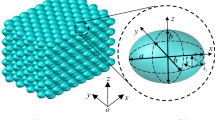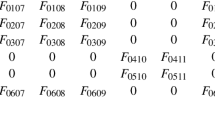Abstract
For a simple cubic lattice of spherical particles with three translational and three rotational degrees of freedom, using the method of structural modeling, discrete, long-wavelength continuum and higher-order gradient models are developed. The higher-order gradient model of such a medium is compared with the Lame equations for cubic symmetry media. From this comparison, the relationships are established between the second-order elastic constants and the microstructure parameters of this medium such as the size of particles and the parameters of their force and torque interactions. Based on the dependences found, the relationship between Poisson’s ratios of the considered anisotropic material and its structural parameters is analyzed. It is found that, at some values of the microstructure parameters, this medium can manifest the auxetic properties.











Similar content being viewed by others
References
Landau, L.D., Lifshitz, E.M.: Theory of Elasticity (Translated from Russian by J. B. Sykes and W. H. Reid). Pergamon Press, London, p. 134 (1959)
Evans, K.E.: Auxetic polymers: a new range of materials. Endeavour 15, 170–174 (1991)
Konyok, D.A., Wojciechowski, K.W., Pleskachevsky, Y.M., Shilko, S.V.: Materials with negative Poisson’s ratio (The review). Compos. Mech. Des. 10, 35–69 (2004). (in Russian)
Lim, T.C.: Micromechanical models for auxetic materials. In: Auxetic Materials and Structures and Engineering Materials, pp. 45–105. Springer, Singapore (2015). https://doi.org/10.1007/978-981-287-275-3_2
Kelkar, P.U., Kim, H.S., Cho, K.-H., Kwak, J.Y., Kang, C.-Y., Song, H.-C.: Cellular auxetic structures for mechanical metamaterials: a review. Sensors 20, 3132 (2020). https://doi.org/10.3390/s20113132
Wu, W., Hu, W., Qian, G., Liao, H., Xu, X., Berto, F.: Mechanical design and multifunctional applications of chiral mechanical metamaterials: a review. Mater. Des. 180, 107950 (2019). https://doi.org/10.1016/j.matdes.2019.107950
Gorodtsov, V.A., Lisovenko, D.S.: Auxetics among materials with cubic anisotropy. Mech. Solid. 55, 461–474 (2020). https://doi.org/10.3103/S0025654420040044
Zubov, V.G., Firsova, M.M.: Elastic properties of quartz near the \(\alpha \)-\(\beta \) transition. Soviet Phys. Crystallogr. 7, 374–376 (1962)
Veronda, D.R., Westmann, R.A.: Mechanical characterization of skin-finite deformations. J. Biomech. 3, 111–124 (1970)
Williams, J.L., Lewis, J.L.: Properties and an anisotropic model of cancellous bone from the proximal tibial epiphysis. J. Biomech. Eng. 104, 50–56 (1982)
Li, Y.: The anisotropic behavior of Poisson’s ratio, Young’s modulus, and shear modulus in hexagonal materials. Phys. Status Solidi (A) 38, 171–175 (1976)
Gunton, D.J., Saunders, G.A.: The Young’s modulus and Poisson’s ratio of arsenic, antimony and bismuth. J. Mater. Sci. 7, 1061–1068 (1972)
Kimizuka, H., Kaburaki, H., Kogure, Y.: Mechanism for negative Poisson ratios over the \(\alpha \)-\(\beta \) transition of cristobalite, SiO\(_{2}\): a molecular-dynamics study. Phys. Rev. Lett. 84, 5548–5551 (2000)
Grima, J.N., Gatt, R., Alderson, A., Evans, K.E.: On the origin of auxetic behaviour in the silicate \(\alpha \)-cristobalite. J. Mater. Chem. 15, 4003–4005 (2005)
Yeganeh-Haeri, A., Weidner, D.J., Parise, J.B.: Elasticity of \(\alpha \)-cristobalite: a silicon dioxide with a negative Poisson’s ratio. Science 257(5070), 650–652 (1992). https://doi.org/10.1126/science.257.5070.650
Keskar, N.R., Chelikowsky, J.R.: Negative Poisson ratios in crystalline SiO\(_{2}\) from first-principles calculations. Nature 358(6383), 222–224 (1992). https://doi.org/10.1038/358222a0
Grima, J.N., Gatt, R., Alderson, A., Evans, K.E.: On the origin of auxetic behaviour in the silicate \(\alpha \)-cristobalite. Mater. Chem. 15(37), 4003–4005 (2005). https://doi.org/10.1039/b508098c
Grima-Cornish, J.N., Vella-żarb, L., Wojciechowski, K.W., Grima, J.N.: Shearing deformations of \(\beta \)-cristobalite-like boron arsenate. Symmetry 13(6), 977 (2021). https://doi.org/10.3390/sym13060977
Jiang, J.-W., Park, H.S.: Negative Poisson’s ratio in single-layer black phosphorus. Nat. Commun. 5, 4727 (2014). https://doi.org/10.1038/ncomms5727
Novikova, N.E., Lisovenko, D.S., Sizova, N.L.: Peculiarities of the structure, moduli of elasticity, and Knoop indentation patterns of deformation and fracture of single crystals of potassium, rubidium, cesium, and ammonium hydrophthalates. Crystallogr. Rep. 63(3), 438–450 (2018). https://doi.org/10.1134/S1063774518030197
Ji, S., Li, L., Motra, H.B., Wuttke, F., Sun, S., Michibayashi, K., Salisbury, M.H.: Poisson’s ratio and auxetic properties of natural rocks. J. Geophys. Res. Sol. Earth 123, 1161–1185 (2018)
Zaitsev, V.Y., Radostin, A.V., Pasternak, E., Dyskin, A.: Extracting real-crack properties from non-linear elastic behavior of rocks: abundance of cracks with dominating normal compliance and rocks with negative Poisson ratios. Nonlinear Proc. Geophys. 24, 543–551 (2017)
Baughman, R.H., Shacklette, J.M., Zakhidov, A.A., Stafström, S.: Negative Poisson’s ratios as a common feature of cubic metals. Nature 392, 362–365 (1998). https://doi.org/10.1038/32842
Lakes, R.: Foam structures with a negative Poisson’s ratio. Science 235, 1038–1041 (1987)
Ren, X., Das, R., Tran, P., Ngo, T.D., Xie, Y.M.: Auxetic metamaterials and structures: a review. Smart Mater. Struct. 27, 23001 (2018). https://doi.org/10.1088/1361-665X/aaa61c
Agnelli, F., Constantinescu, A., Nika, G.: Design and testing of 3D-printed micro-architectured polymer materials exhibiting a negative Poisson’s ratio. Contin. Mech. Thermodyn. 32, 433–449 (2020). https://doi.org/10.1007/s00161-019-00851-6
Solyaev, Y., Lurie, S., Ustenko, A.: Numerical modeling of a composite auxetic metamaterials using micro-dilatation theory. Contin. Mech. Thermodyn. 31, 1099–1107 (2019). https://doi.org/10.1007/s00161-018-0730-y
Zhou, L., Jiang, H.: Auxetic composites made of 3D textile structure and polyurethane foam. Phys. Status Solidi B 253, 1331–1341 (2016)
Goldstein, R.V., Gorodtsov, V.A., Lisovenko, D.S.: Auxetic mechanics of crystalline materials. Mech. Solids 45, 529–545 (2010)
Fedotovskii, V.S.: A Porous medium as an acoustic metamaterial with negative inertial and elastic properties. Acoust. Phys. 64, 548–554 (2018)
Hall, L.J., Coluci, V.R., Galvão, D.S., Kozlov, M.E., Zhang, M., Dantas, S.O., Baughman, R.H.: Sign change of Poisson’s ratio for carbon nanotube sheets. Science 320, 504–507 (2008)
Goldstein, R.V., Gorodtsov, V.A., Lisovenko, D.S.: Young’s moduli and Poisson‘s ratio of curvilinear anisotropic hexagonal and rhombohedral nanotubes. Nanotubes-auxetics. Doklady Phys. 58, 400–404 (2013)
Baimova, J.A., Rysaeva, L.K., Dmitriev, S.V., Lisovenko, D.S., Gorodtsov, V.A., Indeitsev, D.A.: Auxetic behaviour of carbon nanostructures. Mater. Phys. Mech. 33, 1–11 (2017)
Evans, K.E., Alderson, A.: Auxetic materials: functional materials and structures from lateral thinking. Adv. Mater. 12, 617–628 (2000)
Underhill, R.S.: Defence applications of auxetic materials. Defense Syst. Inf. Anal. Center J. 1, 7–13 (2014)
Liu, Q.: Literature review: materials with negative Poisson’s ratios and potential applications to aerospace and defence. Aust. Gov. Dep. Def (2006)
Choi, J.B., Lakes, R.S.: Fracture toughness of re-entrant foam materials with a negative Poisson’s ratio: experiment and analysis. Int. J. Fract. 80, 73–83 (1996)
Donoghue, J.P., Alderson, K.L., Evans, K.E.: The fracture toughness of composite laminates with a negative Poisson’s ratio. Phys. Status Solidi (B) 246, 2011–2017 (2009)
Alderson, K.L., Webber, R.S., Mohammed, U.F., Murphy, E., Evans, K.E.: An experimental study of ultrasonic attenuation in microporous polyethylene. Appl. Acoust. 50, 23–33 (1997)
Howell, B., Prendergast, P., Hansen, L.: Examination of acoustic behavior of negative Poisson’s ratio materials. Appl. Acoust. 43, 141–148 (1994)
Mazaev, A.V., Ajeneza, O., Shitikova, M.V.: Auxetics materials: classification, mechanical properties and applications. IOP Conf. Ser. Mater. Sci. Eng. 747, 012008 (2020)
Theocaris, P.S., Stavroulakis, G.E., Panagiotopoulos, P.D.: Negative Poisson’s ratios in composites with star-shaped inclusions: a numerical homogenization approach. Arch. Appl. Mech. 67, 274–286 (1997)
Wang, Z.-P., Hien Poh, L., Dirrenberger, J., Zhu, Y., Forest, S.: Isogeometric shape optimization of smoothed petal auxetic structures via computational periodic homogenization. Comput. Methods Appl. Mech. Eng. 323, 250–271 (2017)
Grima, J.N., Gatt, R., Alderson, A., Evans, K.E.: On the auxetic properties of “rotating rectangles’’ with different connectivity. J. Phys. Soc. Jpn. 74, 2866–2867 (2005)
Grima, J.N., Farrugia, P.-S., Gatt, R., Attard, D.: On the auxetic properties of rotating rhombi and parallelograms: a preliminary investigation. Phys. Status Solidi (B) 245, 521–529 (2008)
Grima, J.N., Chetcuti, E., Manicaro, E., Attard, D., Camilleri, M., Gatt, R., Evans, K.E.: On the auxetic properties of generic rotating rigid triangles. Proc. Roy. Soc. A Math. Phys. Eng. Sci. 468, 810–830 (2012)
Grima, J.N., Gatt, R., Farrugia, P.-S.: On the properties of auxetic meta-tetrachiral structures. Phys. Status Solidi (B) 245, 511–520 (2008)
Vasiliev, A.A., Pavlov, I.S.: Auxetic properties of chiral hexagonal Cosserat lattices composed of finite-sized particles. Phys. Status Solidi B 257, 1900389 (2020)
Yingli, L., Gengwang, Y.: Vibration characteristics of innovative reentrant-chiral elastic metamaterials. Eur. J. Mech. A Solid 90, 104350 (2021)
Ha, C.S., Plesha, M.E., Lakes, R.S.: Chiral three-dimensional lattices with tunable Poisson’s ratio. Smart Mater. Struct. 25, 054005 (2016). https://doi.org/10.1088/0964-1726/25/5/054005
Caddock, B.D., Evans, K.E.: Microporous materials with negative Poisson’s ratios. I. Microstructure and mechanical properties. J. Phys. D Appl. Phys. 22, 1877–1882 (1989)
Norris, A.N.: Poisson’s ratio in cubic materials. Proc. Roy. Soc. A Math. Phys. Eng. Sci. 462, 3385–3405 (2006). https://doi.org/10.1098/rspa.2006.1726
Epishin, A.I., Lisovenko, D.S.: Extreme values of the Poisson’s ratio of cubic crystals. Tech. Phys. 61, 1516–1524 (2016). https://doi.org/10.1134/S1063784216100121
Ha, C.S., Plesha, M.E., Lakes, R.S.: Chiral three-dimensional isotropic lattices with negative Poisson’s ratio. Phys. Status Solidi (B) 253, 1243–1251 (2016)
Cabras, L., Brun, M.: A class of auxetic three-dimensional lattices. J. Mech. Phys. Solids. 91, 56–72 (2016)
Kim, J., Shin, D., Yoo, D.-S., Kim, K.: Regularly configured structures with polygonal prisms for three-dimensional auxetic behaviour. Proc. Roy. Soc. A Math. Phys. Eng. Sci. 473, 20160926 (2017)
Duan, S., Wen, W., Fang, D.: A predictive micropolar continuum model for a novel three-dimensional chiral lattice with size effect and tension-twist coupling behavior. J. Mech. Phys. Solids. 121, 23–46 (2018). https://doi.org/10.1016/j.jmps.2018.07.016
Yang, L., Harrysson, O., West, H., Cormier, D.: Mechanical properties of 3D re-entrant honeycomb auxetic structures realized via additive manufacturing. Int. J. Solids Struct. 69, 475–490 (2015)
Wang, X.-T., Wang, B., Li, X.-W., Ma, L.: Mechanical properties of 3D re-entrant auxetic cellular structures. Int. J. Mech. Sci. 131, 396–407 (2017)
Wojciehowski, K.W.: Negative Poisson ratios at negative pressures. Mol. Phys. Rep. 10, 129–136 (1995)
Lethbridge, Z.A.D., Walton, R.I., Marmier, A., Smith, C.W., Evans, K.E.: Elastic anisotropy and extreme Poisson’s ratios in single crystals. Acta Mater. 58, 6444–6451 (2010)
Turley, J., Sines, G.: The anisotropy of Young’s modulus, shear modulus and Poisson’s ratio in cubic materials. J. Phys. D Appl. Phys. 4, 264–271 (1971)
Belomestnykh, V.N., Soboleva, E.G.: Unconventional approach to determination anisotropic Poisson’s ratios in cubic crystals. Lett. Mater. 2, 13–16 (2012)
Erofeev, V.I., Pavlov, I.S.: Parametric identification of crystals having a cubic lattice with negative Poisson’s ratios. J. Appl. Mech. Tech. Phys. 56, 1015–1022 (2015)
Second and Higher Order Elastic Constants. In: Nelson, D.F. (ed.). V. 29a of Landolt-Bornstein—Group III Condensed Matter. Springer (1992)
Branka, A.C., Heyes, D.M., Wojciechowski, K.W.: Auxeticity of cubic materials. Phys. Status Solidi B 246, 2063–2071 (2009)
Eringen, A.C.: Microcontinuum Field Theories. 1: Foundation and Solids. Springer, New York (1999)
Grekova, E., Porubov, A., dell’Isola, F.: Reduced linear constrained elastic and viscoelastic homogeneous Cosserat media as acoustic metamaterials. Symmet. MDPI 12, 521–543 (2020)
Erofeev, V.I., Pavlov, I.S.: Structural Modeling of Metamaterials. Advanced Structured Materials, vol. 144. Springer, Switzerland (2021)
Pavlov, I.S., Potapov, A.I., Maugin, G.A.: A 2D granular medium with rotating particles. Int. J. Solids Struct. 43, 6194–6207 (2006)
Vasiliev, A.A., Dmitriev, S.V., Ishibashi, Y., Shigenari, T.: Elastic properties of a two-dimensional model of crystals containing particles with rotational degrees of freedom. Phys. Rev. B 65, 094101 (2002). https://doi.org/10.1103/PhysRevB.65.094101
Potapov, A.I., Pavlov, I.S., Lisina, S.A.: Identification of nanocrystalline media by acoustic spectroscopy methods. Accoust. Phys. 56, 588–596 (2010). https://doi.org/10.1134/S1063771010040251
Potapov, A.I., Pavlov, I.S., Lisina, S.A.: Acoustic identification of nanocrystalline media. J. Sound Vib. 322, 564–580 (2009)
Vanin, G.A.: Gradient theory of elasticity. Mech. Solids 1, 46–53 (1999)
Ieşan, D., Quintanilla, R.: On chiral effects in strain gradient elasticity. Eur. J. Mech. A Solid 58, 233–246 (2016)
Rysaeva, L.K., Baimova, J.A., Lisovenko, D.S., Gorodtsov, V.A., Dmitriev, S.V.: Elastic properties of fullerites and diamond-like phases. Phys. Status Solidi B 256, 1800049 (2019). https://doi.org/10.1016/j.commatsci.2019.109355
Acknowledgements
The research was carried out under the financial support of the Russian Science Foundation (Grant No. 21-19-00813).
Author information
Authors and Affiliations
Corresponding author
Additional information
Communicated by Andreas Öchsner.
Publisher's Note
Springer Nature remains neutral with regard to jurisdictional claims in published maps and institutional affiliations.
Rights and permissions
Springer Nature or its licensor (e.g. a society or other partner) holds exclusive rights to this article under a publishing agreement with the author(s) or other rightsholder(s); author self-archiving of the accepted manuscript version of this article is solely governed by the terms of such publishing agreement and applicable law.
About this article
Cite this article
Pavlov, I.S., Dmitriev, S.V., Vasiliev, A.A. et al. Models and auxetic characteristics of a simple cubic lattice of spherical particles. Continuum Mech. Thermodyn. 34, 1669–1685 (2022). https://doi.org/10.1007/s00161-022-01157-w
Received:
Accepted:
Published:
Issue Date:
DOI: https://doi.org/10.1007/s00161-022-01157-w




